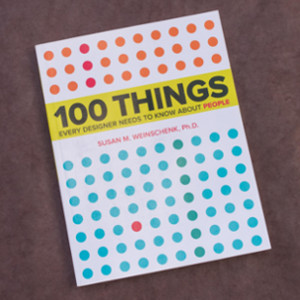
This book’s title is so appealing. It’s like those headlines that call out at you: 21 Ways to Be More Likeable or 36 Foods to Avoid Forever or 49 Tactics to Save Your Relationship. The promise of quantifiable knowledge can feel irresistible.
It makes sense that the author would use an attention-getting trick, because it’s part of her expertise. Susan M. Weinschenk has a Ph.D. in Psychology and has spent 30 years linking research findings about human behaviour to how we can better design technology. This book is a fascinating tour of ways to create products that match the way people actually think and behave.
100 things? You might expect such a long list to be overwhelming. Fortunately, the author groups the book’s content into 10 broad themes:
- How People See
- How People Read
- How People Remember
- How People Think
- How People Focus Their Attention
- What Motivates People
- People Are Social Animals
- How People Feel
- People Make Mistakes
- How People Decide
These groupings help make 100 Things approachable, and if you want to go straight to the subject areas that interest you most, it’s easy.
Each of the 100 chapters is brief, typically two or three pages long. Every chapter ends with a box called Takeaways, with a bullet-pointed summary that translates the preceding information into design-related insights.

Sometimes a chapter’s insights can seem obvious. Chapter 9 talks about how people perceive things that are close together as belonging together and uses the example of a photo and text on a web page. One of the takeaways in this chapter reads:
- Put more space between items that don’t go together and less space between items that do. This sounds like common sense, but many Web page layouts ignore this idea.
It may be necessary to be reminded of core design concepts that get forgotten. Whether I was familiar with the ideas or not, I discovered standout chapters throughout the book.
100 Things is peppered with names of researchers and publication dates. Flip to the back and you’ll discover a bibliography with details on the publications behind the book’s ideas. If you’re curious and intrepid, you can visit a library and go further in your learning.
If you read this book, you’ll probably have intermittent aha moments, with stretches of ho-hum moments in-between. It makes for a compelling experience, waiting for these bursts of understanding.
And it follows one of the principles in the book. In Chapter 51, Variable Rewards Are Powerful, we learn about experiments on rats in which they could press a bar to get a food pellet, but it wouldn’t happen with each bar press. The rats would press the bar the most if the reward followed a “variable ratio schedule”: the number of bar presses it took would be unpredictable, but it would average out to a certain ratio. Think of slot machines and you get the idea.
In 100 Things you may not hit the jackpot in every chapter, but keep on playing and in the end the journey itself is a reward.
 100 Things Every Designer Needs to Know About People, by Susan M. Weinschenk, Ph.D.
100 Things Every Designer Needs to Know About People, by Susan M. Weinschenk, Ph.D.
Have you read 100 Things Every Designer Needs to Know About People? Please feel free to share your comments below.